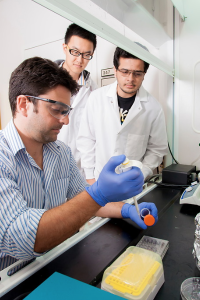Document Type
Article
Publication Title
PLoS ONE
Abstract
Basal release of nitric oxide from endothelial cells modulates contractile activity in the corpus cavernosum via inhibition of the RhoA/Rho-kinase signaling pathway. We aimed to investigate nitric oxide bioavailability, oxidative stress and the Rho-kinase pathway in the relaxation of the corpus cavernosum of an obese and diabetic model of mice (db/db mice). We hypothesized that in db/db mice impaired relaxation induced by Rho-kinase inhibitor is accompanied by diminished NO bioavailability, increased oxidative stress and upregulation of the RhoA/Rho-kinase signalling pathway. Cavernosal strips from male lean and non-diabetic db/+ and db/db mice were mounted in myographs and isometric force in response to Rho-kinase inhibitor Y-27632 was recorded. Enzyme activity and protein expression of oxidative stress markers and key molecules of the RhoA/Rho-kinase pathway were analyzed. The Rho-kinase inhibitor Y-27632 concentration-dependently caused corpus cavernosum relaxation and inhibited cavernosal contractions. Nonetheless, a rightward shift in the curves obtained in corpus cavernosum of db/db mice was observed. Compared to db/+, this strain presented increased active RhoA, higher MYPT-1 phosphorylation stimulated by phenylephrine, and increased expression of ROKα and Rho-GEFs. Further, we observed normal expression of endothelial and neuronal NOS in corpus cavernosum of db/db mice. However, nitrate/nitrate (NOx) levels were diminished, suggesting decreased NO bioavailability. We measured the oxidant status and observed increased lipid peroxidation, with decreased SOD activity and expression. In conclusion, our data demonstrate that in db/db mice, upregulation of the RhoA/Rho-kinase signalling pathway was accompanied by decreased NO bioavailability and increased oxidative stress contributing to impaired relaxation of the corpus cavermosum of db/db mice.
DOI
10.1371/journal.pone.0156030
Publication Date
5-26-2016
Recommended Citation
Priviero, F. B. M., Toque, H. A. F., Nunes, K. P., Priolli, D. G., Teixeira, C. E., & Webb, R. C. (2016). Impaired corpus cavernosum relaxation is accompanied by increased oxidative stress and up-regulation of the rho-kinase pathway in diabetic (db/db) mice. PLoS ONE, 11(5) doi:10.1371/journal.pone.0156030


